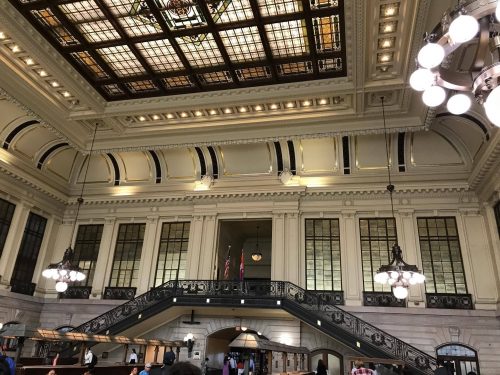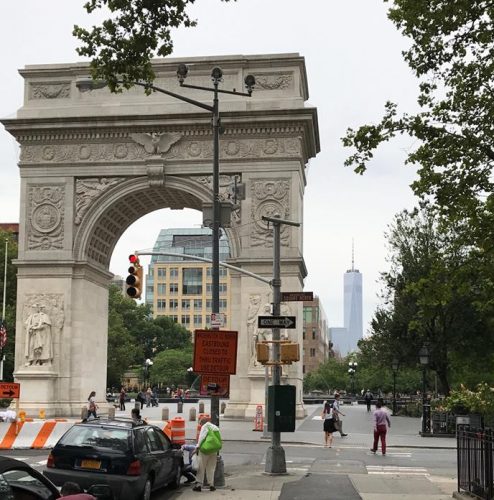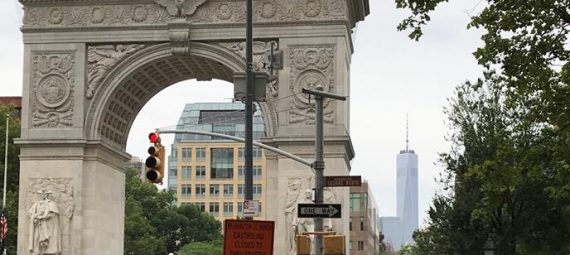Starts, as do most across the civilized world, with a large thermos flask of something as hot as it is caffeinated. The first stage of my journey is the 10 minute drive to Hillsdale Station. Driving through the archetypal American suburbia would be oddly familiar even to those who have never been to the states. It has been immortalized by the television, captured in films and theatre, and the picture that you all have of yellow school buses, wooden board houses draped in stars and stripes, and high schools with bleachers and all, would do well to describe the first part of my Journey.
Hillsdale train station, and indeed all the suburban train stations trickling down through New Jersey to the city are, rather ironically for America, the tiniest and quaintest little stops, stations that would be quite happily be spread across the New Forest or nestled in some Kent village. I wait at the station, on the low platform, which is at exactly the same height as the track itself. There is the understood and revered silence of several commuters. Young college students, on their way into the city to intern at any number of banks or organizations. The old hat commuters, standing exactly in the position where the train’s great doors are to stop, no doubt waiting to pounce on their favorite seat. And me. There is no live timetable of trains, its approach is heralded by the great bells of the three level crossings, each setting off one after the other as their arms slowly lower, wobbling disconcertingly in even a light breeze. Then, coming round the bend comes the deafening bellow of the train’s horn, 3 bright lights and the massive grey beast rushes past before slowing to a halt. As the platform is level with the track, to get into the train, massive 10 ft doors open up and a steep flight of stairs lead you to the carriage. This is more the train of absurd proportions you’d expect from America, quite opposite from the station itself. The first relief, air conditioning. The maroon, plush, leather seats have obviously been maliciously designed to lure unwitting tourists and commuters into a deep sleep, so that they miss their stop and are ultimately sacrificed to the great God of the New Jersey Transit Authority.
The train waits at the platform for a fraction of a minute, before regaining its relentless pace toward the city. The views for the most part are of continued suburbia. Parking lots, malls, houses, factories and houses give plenty to mull over whilst the guard comes around, collecting tickets, and hole punching them in a manner that can only be described as assault. After a half hour, the houses and towns melt away to a marshy area, reeds almost as high as the massive train, form matts for miles either side of the bridge that the train crosses. And across the heads of the cranes, (insert American birds I don’t know here…) you get your first glimpse of the infamous Manhattan skyline. The freedom tower rising boldly above the horizon, joined by her older sister The Empire State building along with a myriad of others. As the MetLife stadium passes by, the train ride to Hoboken station, just opposite the river to Manhattan, comes to its final leg.
Pulling in and getting off at Hoboken station is as one would have seen anyone get off of a train in a 40s gangster movie, long platforms with great globe shaped lights and green metal columns paced intermittently down to the waiting room. The waiting room itself is immensely grand. A large building with a ceiling at least three stories high and ornately decorated. The feet of business men and women click on the marble flooring as they sweep past the dark oak benches lining the edges and centre of the room. I join a new torrent of people as I move out of the grand room, turn left then right and descend below ground.

Hoboken waiting room
Like any subway in countries with 30 oC heat, and a huge body of people, it is hot. As you slide through the tunnel and barge through the turnstile, you notice it. But then as you step aboard the waiting subway train you are hit with a welcome wall of cool air. I’m two for two on air conditioning. A ten-minute ride and the train loops round and barrels away deep under the river toward the city.
9th street is my stop, and rising up a few flights of stairs I emerge from what, to the untrained eye, could very easily be confused with an ATM vestibule. Now I am in the city. The bustle and hive of movement as yellow cabs queue up for their daily drive confirms it beyond a doubt. I turn left onto 9th street and am flanked either side by tall, red stone buildings. Old buildings, a small glimpse of the history that is so well hidden in this modern metropolis. Trees line the road on both sides, in England it would be called an avenue, save for the fact that in New York, any road running from east to west is a street. Walking on I join the very beginning of 5th Avenue and walk down to Washington Square Park. As you walk closer, your eye is drawn to the massive stone arch, commemorating America’s founding father, and exemplifying the principles of liberty and freedom that he embodied to his people. Allowing your eyes to draw slightly to the right you see, raising above the old arch a second dedication of New York to liberty. The freedom tower. Old and new standing as if side by side showing that, on a base level, the principles held dear by the rebels of 1776 still burn strong today.

NYC’s tributes to freedom
The park itself is always alive with activity. Like any city, the citizens love the oasis of green that parks present. Kids (and adults) play in the fountain, dogs chase squirrels around the immaculately kept borders, stranger faces off against stranger on the stone chess tables, and street musicians play the Maple Leaf Rag on an old piano that they have dragged out. Washington Square Park forms the heart of the NYU campus. And, to the left of the arch, lies the beautiful, classic stone building that houses the chemistry department. A quick nod to the plaque celebrating the foundation of the American Chemical Society and I dash inside, show my ID, stand in the old brass and wood elevator that creaks its way up to the 8th floor and the lab.
And all of this for just under 15 $… Take note National Rail, trains can be run without ticket prices requiring a blood sacrifice!

